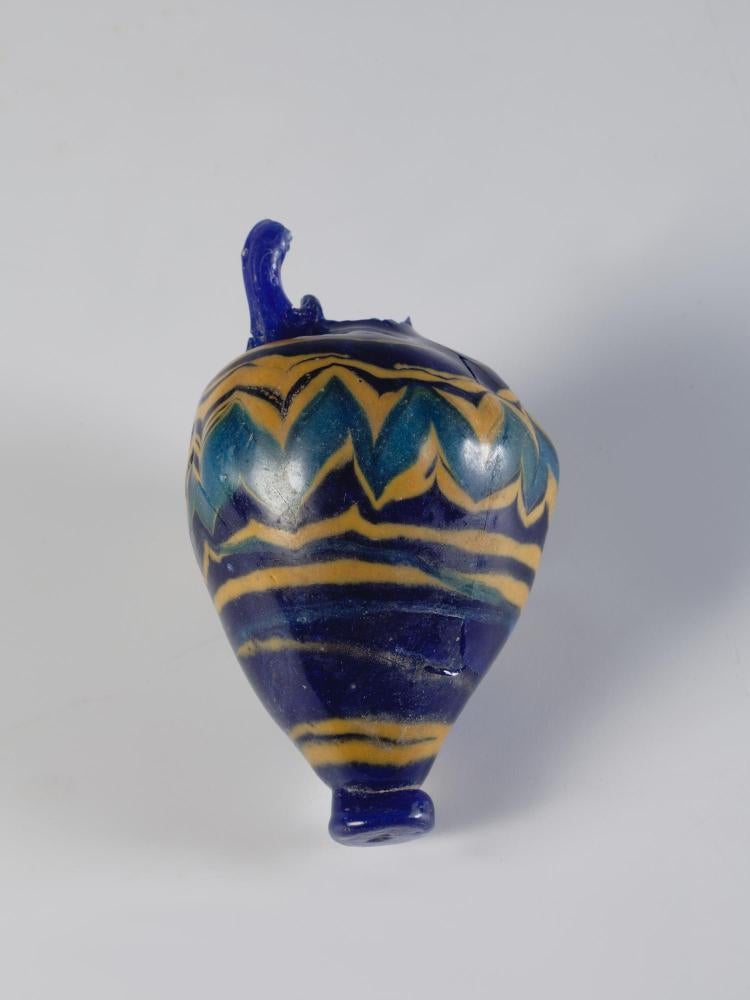2008.18.2.1, Eastern Mediterranean Amphoriskos
Catalogue Entry 

From the Catalogue of Ancient Glass in the University of Colorado Museum
Gift of the May Company (1969)
Transferred to CU Art Museum (2008)
Height: 7.9 cm
Diameter (max.): 4.8 cm
Eastern Mediterranean, late 6th to early 4th century B.C.E.
Classification: Grose Group I.3
Description: Mouth, neck, and part of handle missing. Preserved section of handle attached to top of shoulder. Body ovoid with flat base knob. Royal blue body with opaque aqua and yellow-orange zigzag pattern. One unmarvered yellow-orange stripe at the top of zigzag pattern, two more below, and one at base of vessel (very similar to the coloring of Schlick-Nolte 2002, no. V-11). Body repaired with wax or hot glue. Core-formed (i.e., hot glass is applied to a removable core, either by dipping or trailing threads of glass over the core as it rotates). Handles and base knob applied separately.
Comment: This type of amphoriskos, which was probably used as an ointment bottle, is ubiquitous in the eastern Mediterranean, such places as Egypt (Honey 1946, pl. 1E), Israel (Eliayu Dobkin Pavillion 1981, p. 18), Lebanon (Baramki 1967, pl. V), and Georgia (Vickers and Kakhidze 2001, fig. 21), as well as in Italy (Mariacher 1961, pl. 2), in the 6th through 3rd centuries B.C.E. This coloring, which is also rather commonplace, is probably in imitation of Murrhine ware (1). Other comparable examples are Eisen 1927, pl. 4; Richter 1974, fig. 515; Hayes 1975, no. 12; Constable-Maxwell Collection 1979, lot 5; and Grose 1989, nos. 107 and 108. A late 6th or early 5th century B.C.E. example at the Art Institute of Chicago and a contemporary example at the Metropolitan Museum of Art show how common the style was and suggest what CU's vessel may have looked like when it was complete.
The original museum record of this vessel indicates that the neck was missing at the time of accessioning, but makes no mention of the body being broken, suggesting this damage occurred since 1969.
Discussion
This colorful vessel has the characteristic design and decoration of many other glass pieces from the same time period. In Egypt, Rhodes, and all over the Eastern Mediterranean, blue, yellow, white and turquoise glass bottles were being produced and traded (2). The bright blue that makes up the majority of this vessel's surface may have been meant to imitate either blue marble (also called anhydrite), which was a popular material for stone vessels (3), or a blue stone called lapis lazuli (4).
The amphoriskos in the CU Art Museum collection was not blown into shape like most later glass vases, but instead was manufactured by a method called core-forming. This means that the shape of the piece comes from a core that was dipped or wrapped in pliable, melted glass. The core was likely made out clay and dung (5), which would be stuck at the end of a long rod and then dipped into the base glass, which appears blue in this vase. Then, melted glass strands would be wound around the core to create the yellow, white, and turquoise bands that were so popular. The vase would then be rubbed smooth until all the colors were integrated. To create the zig-zag effect, the glass would be combed with a pointed instrument to drag the colored bands up and down (6). Once the glass was cooled and set, the organic core would be scraped out, leaving only the shaped vessel (7).
This amphoriskos has some unfortunate damage to the mouth and neck. Amphoriskoi held scented oils and perfumes and were very common vases in the Mediterranean world from about 525 B.C.E. to 50 B.C.E. The manufacture and trade of perfumes was an essential industry to the Egyptians and the Rhodians. Other popular shapes included aryballoi and alabastra, both also used for carrying scented oils and perfumes (8).
Footnotes
- Alain Tressaud and Michael Vickers, "Ancient Murrhine Ware and Its Glass Evocations," Journal of Glass Studies 49 (2007): 143-152.
- Hugh Tait, ed., Five Thousand Years of Glass (Philadelphia: University of Pennsylvania Press, 2004): 26-44.
- Tait 2004: 33.
- Martine S. Newby, Glass of Four Millennia (Oxford: Ashmolean Museum, 2000): 12.
- Robert J. Charleston, Masterpieces of Glass: A World History from the Corning Museum of Glass (New York: Harry N. Abrams, Inc. 1980): 19.
- R. A. Grossmann, Ancient Glass: A Guide to the Yale Collection (New Haven: Yale University Art Gallery, 2002): 13.
- Newby 2000: 12.
- Tait 2004: 42-43.
References
- Baramki, D. The Archaeological Museum of the American University of Beirut. Beirut: The American University, 1967.
- Catalogue of the Constable-Maxwell Collection of Ancient Glass. London: Maggs Brothers, 1979.
- Eisen, G. A. Glass: Its Origin, History, Chronology, Technic and Classification to the Sixteenth Century, v. 1. New York: W. E. Rudge, 1927.
- The Eliyahu Dobkin Pavilion of Glass from Eretz Israel and Neighboring Countries. Jerusalem: Israel Museum, 1981.
- Grose, D. F. Early Ancient Glass: Core-Formed, Rod-Formed, and Cast Vessels and Objects from the Late Bronze Age to the Early Roman Empire, 1600 B.C. to A.D. 50. New York: Hudson Hills Press, 1989.
- Hayes, J. W. Roman and Pre-Roman Glass in the Royal Ontario Museum. Toronto: 1975.
- Honey, W. B. Glass: A Handbook for the Study of Glass Vessels of All Periods and Countries & a Guide to the Museum Collection. London: Ministry of Education, 1946.
- Mariacher, G. Italian Blown Glass from Ancient Rome to Venice. New York: McGraw-Hill, 1961.
- Richter, G. M. A. A Handbook of Greek Art. Oxford: Phaidon, 1974.
- Schlick-Nolte, B. “Catalogue of Ancient Glass,” in Reflections on Ancient Glass from the Borowski Collection, ed. R. S. Bianchi, B. Schlick-Nolte, G. M. Bernheimer, and Dan Barag. Mainz: P. von Zabern, 2002: 47-109.
- Vickers, M. and A. Kakhidze. “The British-Georgian excavation at Pichvnari 1998: the ‘Greek’ and ‘Colchian’ Cemeteries,” Anatolian Studies 51 (2001): 65-90.

